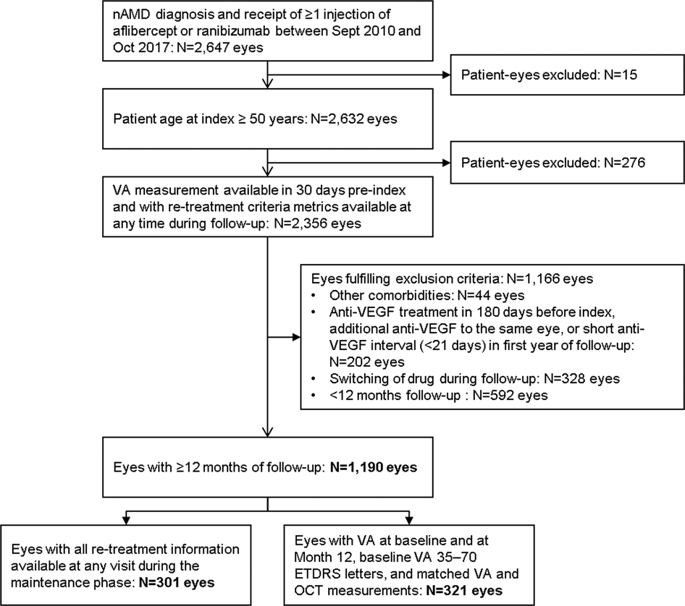Our official English website, www.x-mol.net, welcomes your
feedback! (Note: you will need to create a separate account there.)
Association between visual acuity, lesion activity markers and retreatment decisions in neovascular age-related macular degeneration
Eye ( IF 2.8 ) Pub Date : 2020-02-17 , DOI: 10.1038/s41433-020-0799-y Usha Chakravarthy 1 , Natasha Pillai 2 , Annie Syntosi 3 , Lorna Barclay 2 , Catherine Best 3 , Alexandros Sagkriotis 3
Eye ( IF 2.8 ) Pub Date : 2020-02-17 , DOI: 10.1038/s41433-020-0799-y Usha Chakravarthy 1 , Natasha Pillai 2 , Annie Syntosi 3 , Lorna Barclay 2 , Catherine Best 3 , Alexandros Sagkriotis 3
Affiliation

|
Background/objectives To investigate the association between optical coherence tomography (OCT) markers of lesion activity and changes in visual acuity (VA) during anti-vascular endothelial growth factor (anti-VEGF) therapy of eyes diagnosed with neovascular age-related macular degeneration (nAMD); and how VA and OCT markers are considered in physicians’ decision to retreat with anti-VEGFs. Subjects/methods Retrospective, non-comparative, non-randomised cohort study involving electronic medical record data collected from 1190 patient eyes with nAMD diagnosis at two sites in the United Kingdom. Two sub-cohorts consisting of 321 and 301 eyes, respectively, were selected for analyses. Results In 321 eyes, absence of IRF or SRF at ≥2 clinic visits resulted in a gain of five ETDRS letters from baseline, compared with two letters gained in eyes with <2 clinic visits with absence of IRF ( p = 0.006) or SRF ( p = 0.042). Anti-VEGF treatment was administered at 421 clinic visits, and 308 visits were without treatment. Comparing treatment visits with non-treatment visits, the maximum difference in frequency of OCT markers of lesion activity were for intraretinal fluid (IRF; 24% versus 5%) and subretinal fluid (SRF; 32% versus 5%). Pigment epithelial detachment (PED) was reported in 58% of treatment visits compared with 36% in non-treatment visits. VA loss was not a consistent trigger for retreatment as it was present in 63% of injection visits and in 49% of non-injection visits. Conclusions Retreatment decision making is most strongly influenced by the presence of IRF and SRF and less by the presence of PED or VA loss.
中文翻译:

新生血管性年龄相关性黄斑变性视力、病变活动标志物与再治疗决策之间的关联
背景/目的 研究诊断为新生血管性年龄相关性黄斑变性的眼睛在抗血管内皮生长因子 (anti-VEGF) 治疗期间病变活动的光学相干断层扫描 (OCT) 标志物与视力 (VA) 变化之间的关联。 nAMD); 以及如何在医生决定撤回抗 VEGF 时考虑 VA 和 OCT 标志物。受试者/方法 回顾性、非比较、非随机队列研究,涉及从英国两个地点的 1190 名 nAMD 诊断患者眼睛收集的电子病历数据。选择了分别由 321 和 301 只眼睛组成的两个子队列进行分析。结果 在 321 只眼中,在≥2 次就诊时不存在 IRF 或 SRF 导致比基线增加 5 个 ETDRS 字母,而 < 2 次没有 IRF ( p = 0.006) 或 SRF ( p = 0.042) 的诊所就诊。在 421 次就诊时进行了抗 VEGF 治疗,308 次就诊时未进行治疗。将治疗访问与非治疗访问进行比较,病变活动的 OCT 标志物频率的最大差异是视网膜内液(IRF;24% 对 5%)和视网膜下液(SRF;32% 对 5%)。58% 的治疗就诊报告了色素上皮脱离 (PED),而在非治疗就诊中这一比例为 36%。VA 损失不是再治疗的一致触发因素,因为它出现在 63% 的注射就诊和 49% 的非注射就诊中。结论 再治疗决策受 IRF 和 SRF 的影响最大,而受 PED 或 VA 损失的影响较小。在 421 次就诊时进行了抗 VEGF 治疗,308 次就诊时未进行治疗。将治疗访问与非治疗访问进行比较,病变活动的 OCT 标志物频率的最大差异是视网膜内液(IRF;24% 对 5%)和视网膜下液(SRF;32% 对 5%)。58% 的治疗就诊报告了色素上皮脱离 (PED),而在非治疗就诊中这一比例为 36%。VA 损失不是再治疗的一致触发因素,因为它出现在 63% 的注射就诊和 49% 的非注射就诊中。结论 再治疗决策受 IRF 和 SRF 的影响最大,而受 PED 或 VA 损失的影响较小。在 421 次就诊时进行了抗 VEGF 治疗,308 次就诊时未进行治疗。将治疗访问与非治疗访问进行比较,病变活动的 OCT 标志物频率的最大差异是视网膜内液(IRF;24% 对 5%)和视网膜下液(SRF;32% 对 5%)。58% 的治疗就诊报告了色素上皮脱离 (PED),而在非治疗就诊中这一比例为 36%。VA 损失不是再治疗的一致触发因素,因为它出现在 63% 的注射就诊和 49% 的非注射就诊中。结论 再治疗决策受 IRF 和 SRF 的影响最大,而受 PED 或 VA 损失的影响较小。病变活动的 OCT 标记频率的最大差异是视网膜内液(IRF;24% 对 5%)和视网膜下液(SRF;32% 对 5%)。58% 的治疗就诊报告了色素上皮脱离 (PED),而在非治疗就诊中这一比例为 36%。VA 损失不是再治疗的一致触发因素,因为它出现在 63% 的注射就诊和 49% 的非注射就诊中。结论 再治疗决策受 IRF 和 SRF 的影响最大,而受 PED 或 VA 损失的影响较小。病变活动的 OCT 标记频率的最大差异是视网膜内液(IRF;24% 对 5%)和视网膜下液(SRF;32% 对 5%)。58% 的治疗就诊报告了色素上皮脱离 (PED),而在非治疗就诊中这一比例为 36%。VA 损失不是再治疗的一致触发因素,因为它出现在 63% 的注射就诊和 49% 的非注射就诊中。结论 再治疗决策受 IRF 和 SRF 的影响最大,而受 PED 或 VA 损失的影响较小。VA 损失不是再治疗的一致触发因素,因为它出现在 63% 的注射就诊和 49% 的非注射就诊中。结论 再治疗决策受 IRF 和 SRF 的影响最大,而受 PED 或 VA 损失的影响较小。VA 损失不是再治疗的一致触发因素,因为它出现在 63% 的注射就诊和 49% 的非注射就诊中。结论 再治疗决策受 IRF 和 SRF 的影响最大,而受 PED 或 VA 损失的影响较小。
更新日期:2020-02-17
中文翻译:

新生血管性年龄相关性黄斑变性视力、病变活动标志物与再治疗决策之间的关联
背景/目的 研究诊断为新生血管性年龄相关性黄斑变性的眼睛在抗血管内皮生长因子 (anti-VEGF) 治疗期间病变活动的光学相干断层扫描 (OCT) 标志物与视力 (VA) 变化之间的关联。 nAMD); 以及如何在医生决定撤回抗 VEGF 时考虑 VA 和 OCT 标志物。受试者/方法 回顾性、非比较、非随机队列研究,涉及从英国两个地点的 1190 名 nAMD 诊断患者眼睛收集的电子病历数据。选择了分别由 321 和 301 只眼睛组成的两个子队列进行分析。结果 在 321 只眼中,在≥2 次就诊时不存在 IRF 或 SRF 导致比基线增加 5 个 ETDRS 字母,而 < 2 次没有 IRF ( p = 0.006) 或 SRF ( p = 0.042) 的诊所就诊。在 421 次就诊时进行了抗 VEGF 治疗,308 次就诊时未进行治疗。将治疗访问与非治疗访问进行比较,病变活动的 OCT 标志物频率的最大差异是视网膜内液(IRF;24% 对 5%)和视网膜下液(SRF;32% 对 5%)。58% 的治疗就诊报告了色素上皮脱离 (PED),而在非治疗就诊中这一比例为 36%。VA 损失不是再治疗的一致触发因素,因为它出现在 63% 的注射就诊和 49% 的非注射就诊中。结论 再治疗决策受 IRF 和 SRF 的影响最大,而受 PED 或 VA 损失的影响较小。在 421 次就诊时进行了抗 VEGF 治疗,308 次就诊时未进行治疗。将治疗访问与非治疗访问进行比较,病变活动的 OCT 标志物频率的最大差异是视网膜内液(IRF;24% 对 5%)和视网膜下液(SRF;32% 对 5%)。58% 的治疗就诊报告了色素上皮脱离 (PED),而在非治疗就诊中这一比例为 36%。VA 损失不是再治疗的一致触发因素,因为它出现在 63% 的注射就诊和 49% 的非注射就诊中。结论 再治疗决策受 IRF 和 SRF 的影响最大,而受 PED 或 VA 损失的影响较小。在 421 次就诊时进行了抗 VEGF 治疗,308 次就诊时未进行治疗。将治疗访问与非治疗访问进行比较,病变活动的 OCT 标志物频率的最大差异是视网膜内液(IRF;24% 对 5%)和视网膜下液(SRF;32% 对 5%)。58% 的治疗就诊报告了色素上皮脱离 (PED),而在非治疗就诊中这一比例为 36%。VA 损失不是再治疗的一致触发因素,因为它出现在 63% 的注射就诊和 49% 的非注射就诊中。结论 再治疗决策受 IRF 和 SRF 的影响最大,而受 PED 或 VA 损失的影响较小。病变活动的 OCT 标记频率的最大差异是视网膜内液(IRF;24% 对 5%)和视网膜下液(SRF;32% 对 5%)。58% 的治疗就诊报告了色素上皮脱离 (PED),而在非治疗就诊中这一比例为 36%。VA 损失不是再治疗的一致触发因素,因为它出现在 63% 的注射就诊和 49% 的非注射就诊中。结论 再治疗决策受 IRF 和 SRF 的影响最大,而受 PED 或 VA 损失的影响较小。病变活动的 OCT 标记频率的最大差异是视网膜内液(IRF;24% 对 5%)和视网膜下液(SRF;32% 对 5%)。58% 的治疗就诊报告了色素上皮脱离 (PED),而在非治疗就诊中这一比例为 36%。VA 损失不是再治疗的一致触发因素,因为它出现在 63% 的注射就诊和 49% 的非注射就诊中。结论 再治疗决策受 IRF 和 SRF 的影响最大,而受 PED 或 VA 损失的影响较小。VA 损失不是再治疗的一致触发因素,因为它出现在 63% 的注射就诊和 49% 的非注射就诊中。结论 再治疗决策受 IRF 和 SRF 的影响最大,而受 PED 或 VA 损失的影响较小。VA 损失不是再治疗的一致触发因素,因为它出现在 63% 的注射就诊和 49% 的非注射就诊中。结论 再治疗决策受 IRF 和 SRF 的影响最大,而受 PED 或 VA 损失的影响较小。











































 京公网安备 11010802027423号
京公网安备 11010802027423号